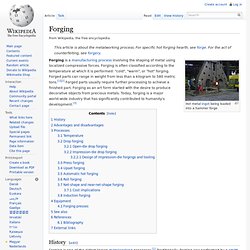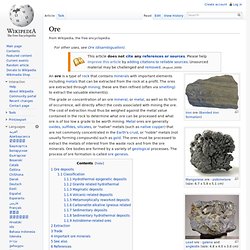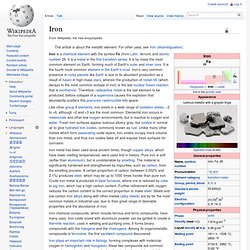

Sometimes a wolf's got to chew it's own leg off. Recycling/Environment. Ferrous metal recycling. A pile of steel scrap in Brussels, waiting to be recycled Ferrous metals are able to be recycled with steel being one of the most recycled materials in the world,.[1] Ferrous metals contain an appreciable percentage of iron and the addition of carbon and other substances creates steel.

The Universal Symbol for Recyclable Steel The CEN Symbol for Recyclable Steel In the USA, steel containers, cans, automobiles, appliances, and construction materials contribute the greatest weight of re-cycled materials. For example, in 2008, more than 97% of structural steel and 106% of automobiles were recycled, comparing the current steel consumption for each industry with the amount of recycled steel being produced (the late 2000s recession and the associated sharp decline in automobile production in the USA explains the over-100% calculation).[2] A typical appliance is about 75% steel by weight[3] and automobiles are about 65% steel and iron.[4] Types of scrap used in steelmaking[edit] United States[edit]
Non-ferrous Metal Recycling. Exam Prep. Previous Exam Paper. AQA-PROD3-INS-JUN13. AQA-PROD3-QP-JUN13. AQA-PROD3-W-INS-JUN11. AQA-PROD3-W-QP-JUN11. AQA-PROD3-W-MS-JUN12.PDF. AQA-PROD3-INS-JUN12. AQA-PROD3-QP-JUN12. AQA-PROD3-W-MS-JUN12. Assessment Criteria. Processes. Metal Processes. Drop Forging. Forging. This article is about the metalworking process.

For specific hot forging hearth, see forge. For the act of counterfeiting, see forgery. Hot metal ingot being loaded into a hammer forge Forging is a manufacturing process involving the shaping of metal using localized compressive forces. Forging is often classified according to the temperature at which it is performed: "cold", "warm", or "hot" forging. Press forming. Pressing. MIG welding. Sintering. Wood Processes. Steam Bending. Veneers. Lamination. Polymer processes. Blow moulding. Pet_extrusion_blow_molding. Rotational moulding. 501226700200jpg_00000046623.
Extrusion. Fetch.php?w=&h=&cache=cache&media=polymer_extrusion. Vacuum moulding. 5420856. INJECTION MOULDING. Injectiondrawing. Robin Night and Day. Past & Present designers. Polyprop Chair. Materials. New Materials. Kevlar. High strength to weight ratio. SMART MATERIALS. D 30. Thermocratic ink. Ore. Gold ore (size: 7.5 x 6.1 x 4.1 cm) Ore deposits[edit] An ore deposit is an accumulation of ore.

Now this is distinct from a mineral resource as defined by the mineral resource classification criteria. An ore deposit is one occurrence of a particular ore type. Most ore deposits are named according to either their location (for example, the Witswatersrand, South Africa), or after a discoverer (e.g. the kambalda nickel shoots are named after drillers), or after some whimsy, a historical figure, a prominent person, something from mythology (phoenix, kraken, serepentleopard, etc.) or the code name of the resource company which found it (e.g. Classification[edit] Ore deposits are classified according to various criteria developed via the study of economic geology, or ore genesis. Bauxite. Chromite. Uraninite. Cinnabar. Liquid Mercury. Sperrylite.
Platinum. Chalcocite. Copper. Argentite. Silver. Metals. Ferrous. Steal. Iron. Iron Supports. Iron. Iron chemical compounds, which include ferrous and ferric compounds, have many uses.

Iron oxide mixed with aluminium powder can be ignited to create a thermite reaction, used in welding and purifying ores. It forms binary compounds with the halogens and the chalcogens. Among its organometallic compounds is ferrocene, the first sandwich compound discovered. Iron plays an important role in biology, forming complexes with molecular oxygen in hemoglobin and myoglobin; these two compounds are common oxygen transport proteins in vertebrates.
Iron is also the metal used at the active site of many important redox enzymes dealing with cellular respiration and oxidation and reduction in plants and animals. Characteristics Mechanical properties The mechanical properties of iron and its alloys can be evaluated using a variety of tests, including the Brinell test, Rockwell test and the Vickers hardness test. Phase diagram and allotropes Iron represents an example of allotropy in a metal. Isotopes. Non-Ferrous. Aluminium. CAN. Alluminium. Aluminium. Characteristics Etched surface from a high purity (99.9998%) aluminium bar, size 55×37 mm Physical Aluminium atoms are arranged in a face-centered cubic (fcc) structure.

Aluminium has a stacking-fault energy of approximately 200 mJ/m2.[8] Chemical Corrosion resistance can be excellent due to a thin surface layer of aluminium oxide that forms when the metal is exposed to air, effectively preventing further oxidation. Aluminium is oxidized by water to produce hydrogen and heat: 2 Al + 3 H2O → Al2O3 + 3 H2 This conversion is of interest for the production of hydrogen. Stainless Steal. Aesthetically Pleasing. Woods. Hardwood. Mahogany. Oak. Teak. Lifes a Beech. Softwoods.....Wood's that get beat up in the. Scott's Pine. Douglas fur. Polymers. Polypropylene. HDPE. Bottle things. LDPE. Acrylic.